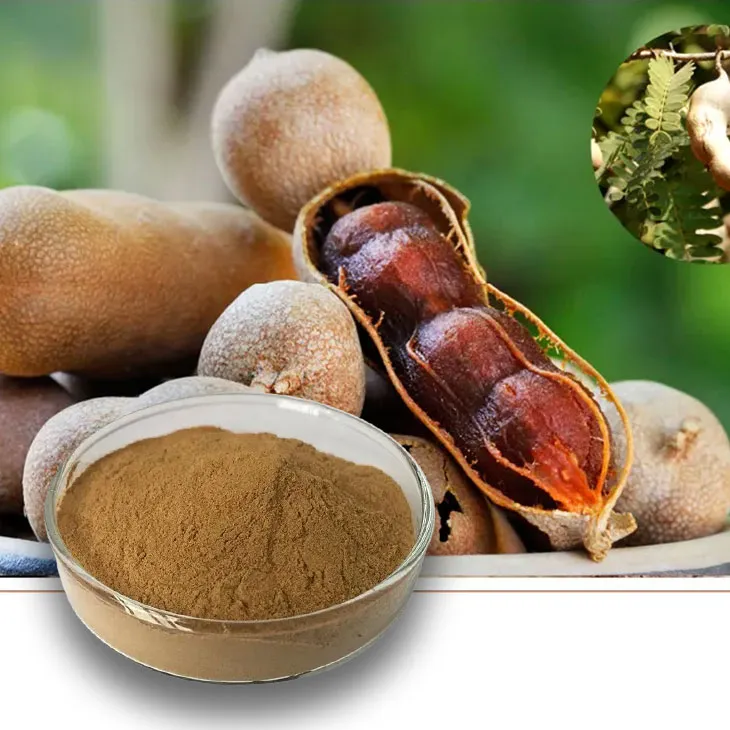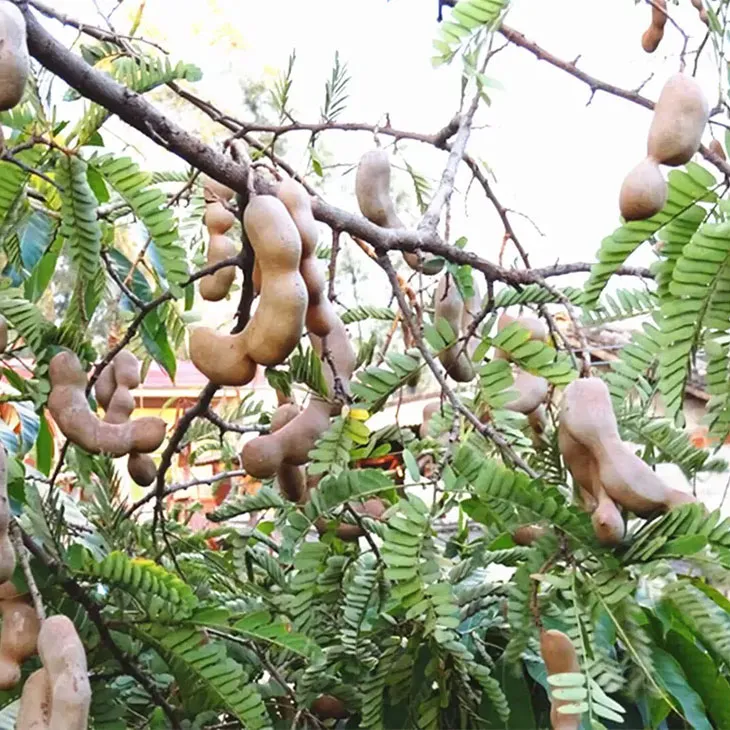- 0086-571-85302990
- sales@greenskybio.com
Extraction process of tamarind extract powder.
2024-11-26

1. Introduction
Tamarind extract powder has gained significant importance in various industries, especially in the food and pharmaceutical sectors. Its unique flavor and potential health benefits make it a valuable ingredient. However, the extraction process of Tamarind extract powder is complex and requires careful attention to detail at each step. This article will explore the entire extraction process in depth.

2. Harvesting of Tamarind
Harvesting Time: The first step in the production of Tamarind extract powder is the harvesting of tamarind fruits. Only ripe fruits are selected for extraction. Ripe tamarind fruits are easily distinguishable by their brown pods and a certain softness to the touch. Harvesting at the right time ensures that the fruits contain the optimal amount of beneficial compounds.
Harvesting Methods: Tamarind fruits are typically harvested by handpicking. This method allows for the selection of only the best - quality fruits. Workers carefully pluck the ripe fruits from the trees, avoiding any unripe or damaged ones. This initial selection process is crucial as it forms the basis for a high - quality extract powder.

3. Pre - processing of Tamarind Fruits
Washing: After harvesting, the tamarind fruits undergo pre - processing. The first step in pre - processing is washing. The fruits are thoroughly washed to remove any dirt, debris, or surface contaminants. This is important not only for the quality of the final product but also for the safety of the extraction process.
Removal of Damaged Parts: Once washed, the fruits are inspected, and any damaged parts are removed. Damaged areas may contain microorganisms or may have started to decompose, which can affect the quality of the extract. This step helps to ensure that only healthy fruit tissue is used for extraction.

4. Extraction from the Tamarind Pulp
4.1 Mechanical Extraction
The main part of the tamarind used for extraction is the pulp. The first method of extraction is mechanical extraction. In this process, the pulp is squeezed to extract the juice. This can be done using mechanical presses. These presses apply pressure to the pulp, forcing the juice out. Mechanical extraction is a relatively simple and straightforward method that can recover a significant amount of the juice from the pulp.
One advantage of mechanical extraction is that it does not introduce any chemical additives at this stage. This helps to maintain the natural properties of the extract. However, mechanical extraction may not be able to extract all the beneficial compounds from the pulp, especially those that are more tightly bound to the pulp matrix.
4.2 Chemical Extraction
To further extract the beneficial compounds from the tamarind pulp, chemical extraction methods may be employed. This is often necessary as some of the valuable substances in the pulp are not easily released by mechanical means alone.
Acid - based Extraction: One common chemical extraction method is the use of acids. In a controlled environment, acids such as citric acid or hydrochloric acid can be used. The acid helps to break down the pulp matrix, releasing more of the substances that are trapped within. For example, acids can help to break down the polysaccharides and release the associated bioactive compounds. However, the use of acids requires careful control of the pH and concentration to avoid over - degradation of the compounds.
Alkali - based Extraction: Another option is alkali - based extraction. Alkalis like sodium hydroxide can be used. Alkali treatment can also disrupt the pulp structure, making it easier to extract the desired substances. But similar to acid - based extraction, strict control of the reaction conditions is necessary to ensure the quality of the extract.

5. Purification of the Tamarind Extract
After extraction, the resulting tamarind extract contains not only the desired beneficial compounds but also various impurities. Therefore, purification is an essential step.
Centrifugation: One of the most common purification techniques is centrifugation. In centrifugation, the extract is spun at high speeds in a centrifuge. This causes the heavier particles, such as cell debris and insoluble substances, to sediment at the bottom of the centrifuge tube, while the purified extract remains in the supernatant. Centrifugation can effectively separate a large portion of the impurities from the extract.
Filtration: Another purification method is filtration. Filtration can be carried out using various types of filters, such as filter papers or membrane filters. The choice of filter depends on the size of the impurities to be removed. Filtration helps to remove any remaining solid particles from the extract, further purifying it.
6. Drying of the Purified Extract
Once the tamarind extract has been purified, it needs to be dried to convert it into a powder form. Drying is carried out at low temperature to preserve the properties of the extract.
Low - Temperature Drying Methods: There are several low - temperature drying methods available. One such method is vacuum drying. In vacuum drying, the extract is placed in a vacuum chamber, and the pressure is reduced. This lowers the boiling point of the water in the extract, allowing it to evaporate at a lower temperature. Another method is freeze - drying. In freeze - drying, the extract is first frozen, and then the ice is sublimated directly from the solid to the gas phase under reduced pressure. Both of these methods help to preserve the bioactive compounds and the flavor of the tamarind extract.
Formation of Powder: After drying, the tamarind extract is in a dry, solid form. This is then ground into a fine powder. The powder is uniform in texture and can be easily incorporated into various products in the food and pharmaceutical industries.
7. Applications of Tamarind Extract Powder
Food Industry: In the food industry, tamarind extract powder is used as a flavoring agent. It imparts a unique sour - sweet flavor to a variety of products, such as candies, sauces, and beverages. It can also be used as a natural preservative due to its antimicrobial properties.
- For example, in the production of tamarind - flavored candies, the extract powder provides the characteristic flavor that consumers love.
- In sauces, it can enhance the flavor profile, adding a tangy and slightly sweet note.
- Tamarind extract powder can also be used in the preparation of traditional beverages in some cultures, giving them a distinct taste.
- Some studies suggest that it may have anti - inflammatory properties, which could be useful in the treatment of certain inflammatory diseases.
- It may also have a role in improving digestion, as tamarind has been traditionally used for digestive ailments.
8. Conclusion
The extraction process of tamarind extract powder is a multi - step and complex procedure. Starting from the careful harvesting of ripe fruits, through pre - processing, extraction, purification, and drying, each step is crucial for obtaining a high - quality product. The resulting tamarind extract powder has a wide range of applications in the food and pharmaceutical industries, making it a valuable natural resource. Continued research and improvement in the extraction process can further enhance the quality and potential applications of tamarind extract powder.
FAQ:
1. What are the criteria for choosing tamarind fruits for extraction?
Only ripe tamarind fruits are chosen for the extraction process. Ripe fruits are likely to have a higher content of beneficial compounds and better quality for extraction.
2. Why is pre - processing important in the production of tamarind extract powder?
Pre - processing, such as washing and removing damaged parts, is important because it helps to ensure the purity and quality of the final product. Dirty or damaged fruits may introduce contaminants or affect the extraction process negatively.
3. What is the role of mechanical extraction in obtaining tamarind extract?
Mechanical extraction is initially used to squeeze out the juice from the tamarind pulp. This is a primary step in obtaining the extract as it helps to separate the liquid containing the beneficial compounds from the solid pulp.
4. How are chemical extraction methods controlled in the tamarind extract production?
When using chemical extraction methods with acids or alkalis, it is done in a controlled environment. This means carefully regulating the concentration of the chemicals, the temperature, and the reaction time to ensure that the pulp is broken down effectively without causing unwanted chemical reactions or degradation of the beneficial substances.
5. Why is low - temperature drying used for the purified tamarind extract?
Low - temperature drying is used to preserve the properties of the purified extract. High temperatures may cause the degradation of the beneficial compounds in the extract, so drying at a low temperature helps to maintain its quality and effectiveness for use in the food and pharmaceutical industries.
Related literature
- Title: Advanced Extraction Techniques for Tamarind Extract Powder"
- Title: "Optimization of Tamarind Extract Powder Production Process"
- Title: "The Chemistry and Extraction of Tamarind Compounds"
- ▶ Hesperidin
- ▶ citrus bioflavonoids
- ▶ plant extract
- ▶ lycopene
- ▶ Diosmin
- ▶ Grape seed extract
- ▶ Sea buckthorn Juice Powder
- ▶ Beetroot powder
- ▶ Hops Extract
- ▶ Artichoke Extract
- ▶ Reishi mushroom extract
- ▶ Astaxanthin
- ▶ Green Tea Extract
- ▶ Curcumin Extract
- ▶ Horse Chestnut Extract
- ▶ Other Problems
- ▶ Boswellia Serrata Extract
- ▶ Resveratrol Extract
- ▶ Marigold Extract
- ▶ Grape Leaf Extract
- ▶ blog3
- ▶ blog4
-
Nature's Bounty Skullcap Extract.
2024-11-26
-
100% Pure Organic Cranberry Extract.
2024-11-26
-
How to make powder from nettle root extract?
2024-11-26
-
Ginseng Leaf Extract Supplier
2024-11-26
-
High - quality longan extract products.
2024-11-26
-
Eucommia Ulmoides Extract
2024-11-26
-
Tinospora cordifolia extract
2024-11-26
-
Lemon Balm Extract
2024-11-26
-
Tamarind extract powder
2024-11-26
-
Yohimbine Bark Extract
2024-11-26
-
Acai Berry Extract
2024-11-26
-
Reishi mushroom extract
2024-11-26
-
Alfalfa Meal
2024-11-26
-
Phyllanthus Emblica Extract
2024-11-26
-
Horse Chestnut Extract
2024-11-26




















